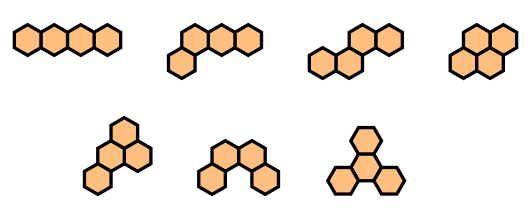• 7 can be written using four 4's:

• There are 7 tetrahexes:

7 has 2 divisors, whose sum is σ = 8. Its totient is φ = 6.
The previous prime is 5. The next prime is 11.
It is a happy number.
7 is nontrivially palindromic in base 2 and base 6.
It is a Cunningham number, because it is equal to 23-1.
7 is an esthetic number in base 3, base 5 and base 7, because in such bases its adjacent digits differ by 1.
It is a weak prime.
It is a sliding number, since 7 = 2 + 5 and 1/2 + 1/5 = 0.7.
It is a cyclic number.
It is not a de Polignac number, because 7 - 21 = 5 is a prime.
Together with 5, it forms a pair of twin primes.
It is a Chen prime.
It is a Harshad number since it is a multiple of its sum of digits (7).
It is a super Niven number, because it is divisible the sum of any subset of its (nonzero) digits.
It is a nude number because it is divisible by every one of its digits and also a Zuckerman number because it is divisible by the product of its digits.
7 is an idoneal number.
It is a tribonacci number.
It is a Lucas number.
It is (trivially) a d-powerful number and an alternating number.
It is the 3-rd Hogben number.
It is a pancake number, because a pancake can be divided into 7 parts by 3 straight cuts.
It is a Carol number, being equal to (22 - 1)2 - 2.
It is a Kynea number, being equal to (21 + 1)2 - 2.
It is one of the 548 Lynch-Bell numbers.
It is the 7-th Perrin number.
It is a partition number, being equal to the number of ways a set of 5 identical objects can be partitioned into subset.
7 is a lucky number.
7 is a nontrivial repdigit in base 2 and base 6.
It is a plaindrome in base 2, base 4, base 5 and base 6.
It is a nialpdrome in base 2, base 3, base 6 and base 7.
It is a zygodrome in base 2 and base 6.
It is a self number, because there is not a number n which added to its sum of digits gives 7.
It is a congruent number.
It is a panconsummate number.
Being equal to 2×22-1, it is a Woodall number.
It is a nontrivial repunit in base 2.
It is a pernicious number, because its binary representation contains a prime number (3) of ones.
It is a Pierpont prime, being equal to 21 ⋅ 31 + 1.
It is a polite number, since it can be written as a sum of consecutive naturals, namely, 3 + 4.
It is an arithmetic number, because the mean of its divisors is an integer number (4).
It is a (trivial) narcissistic number.
7 is the 2-nd heptagonal number.
7 is the 2-nd hex number.
7 is a deficient number, since it is larger than the sum of its proper divisors (1).
7 is an equidigital number, since it uses as much as digits as its factorization.
7 is an odious number, because the sum of its binary digits is odd.
The product of its digits is 7, while the sum is 7.
The square root of 7 is about 2.6457513111. The cubic root of 7 is about 1.9129311828.
The spelling of 7 in words is "seven", and thus it is an aban number, an iban number, an oban number, and an uban number.
• e-mail: info -at- numbersaplenty.com • Privacy notice • done in 0.037 sec. • engine limits •

